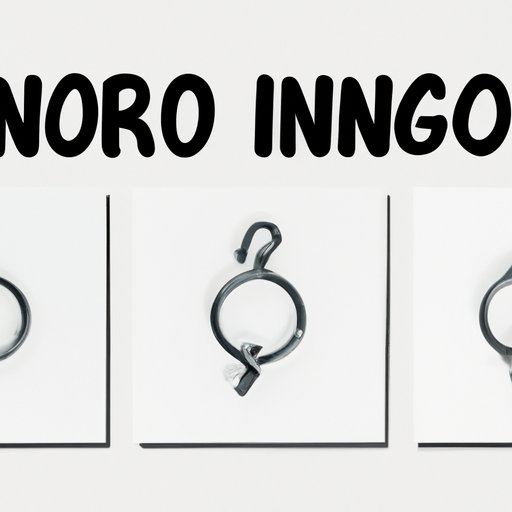
Introduction
A nose piercing is a trendy and coveted accessory, but its beauty can quickly become a source of misery if you do not follow proper care. Taking care of your nose piercing is vital to prevent infections, scarring, and other complications.
This article is essential for anyone who has recently gotten their nose piercing or is considering getting one. You will learn how to clean a nose piercing, common mistakes, DIY solutions, aftercare tips, and myth-busting.
Step-by-step guide
Cleaning a nose piercing is an easy process that only requires a few minutes of your time. However, it is crucial to use the right cleaning products and techniques to ensure your nose piercing remains clean and healthy.
What you need
- Saline wound wash or sea salt solution
- Cotton swabs or pads
Step-by-step instructions for cleaning a nose piercing
- Wash your hands thoroughly with soap and warm water before touching your nose piercing.
- Apply a saline wound wash or sea salt solution to your nostril and around the piercing.
- Leave the solution on for 5-10 minutes.
- Rinse the area with clean, warm water, and then dry with a clean cotton swab or pad.
- Avoid touching or rotating the jewelry.
Suggested cleaning frequency
It is recommended that you clean your nose piercing two times a day, especially during the first few weeks after getting it. After the initial weeks have passed, you can cut down to once a day.
How to overcome difficulties
The healing process for a nose piercing can be painful. Suppose you encounter difficulties such as redness, swelling, or discharge from the piercing. In that case, we recommend that you contact your piercer.
Common mistakes
Cleaning a nose piercing requires a specific set of instructions to ensure you do not damage your skin or jewelry. Here are some common mistakes that people make when cleaning their nose piercing:
– Using alcohol or hydrogen peroxide to clean the area – this can dry out the skin and delay healing.
– Using harsh soaps or ointments – this can lead to skin irritation and clog the piercing.
– Touching the piercing frequently – this can introduce bacteria and lead to infections.
How to avoid mistakes
To avoid the above mistakes and ensure proper healing, follow these tips:
– Use saline wound wash or sea salt solution to clean the piercing.
– Avoid using makeup, hair care products, or perfumes near the piercing.
– Avoid twisting or playing with the jewelry.
Why avoiding mistakes is important
Ignoring proper care instructions for your nose piercing can lead to severe infections, keloids, irritation, pain or migration. These complications may result in a longer healing period or, in extreme cases, may cause the piercing to close.
Do’s and Don’ts
Ensuring proper healing of your nose piercing requires a few dos and don’ts:
Do’s
– Clean your nose piercing twice a day
– Use saline wound wash or sea salt solution to clean the piercing.
– Clean your hands thoroughly before touching the piercing.
Don’ts
– Do not use alcohol or hydrogen peroxide to clean the piercing.
– Do not pick or twist the jewelry.
– Do not sleep on the piercing.
Why following these guidelines is important
Following the above guidelines promotes healing and reduces complications. It ensures that your nose piercing remains clean and healthy and helps you avoid further issues.
DIY solutions
Many people opt for DIY methods for cleaning their nose piercing, but it is essential to ensure that these methods are safe and effective. Here are some DIY solutions that you can try:
Sea salt soak
Dissolve a l/4 teaspoon of sea salt in a cup of warm water and soak your nose in the solution for 5-10 minutes.
Tea tree oil
Dilute tea tree oil with water and apply it around the piercing. Do not apply it directly to the piercing.
Chamomile tea
Boil chamomile tea, let it cool, and apply it to the nose piercing with a clean cotton swab.
Avoid dangerous DIY solutions
Avoid DIY solutions such as hydrogen peroxide, alcohol, and bactine, as they can increase irritation and make healing more challenging.
Aftercare tips
After cleaning your nose piercing, there are some tips you can follow to prevent infections or reduce pain. These include:
– Avoid using harsh soaps or make-up products.
– Apply a warm compress to the area to reduce swelling.
– Sleeping on your back to avoid putting pressure on the piercing.
Understanding the healing process
The healing process for a nose piercing takes 4-6 months on average. However, this may vary depending on your body’s healing abilities.
Myth-busting
There are many myths surrounding the care and cleaning of nose piercings. Here are some myths debunked:
– Myth #1: You need to twist your jewelry while cleaning.
– Fact: Twisting the jewelry can damage your skin and lead to prolonged healing.
– Myth #2: Rubbing alcohol is the best cleaning solution.
– Fact: Rubbing alcohol can dry out your skin and interfere with healing.
– Myth #3: It’s okay to change your jewelry after two weeks.
– Fact: Changing your jewelry too early can cause inflammation and delay healing.
Why these myths are false
Following those myths can harm your skin and prolong healing time. It’s essential to ensure you use the proper cleaning products and techniques to maintain your piercing’s hygiene.
Conclusion
In conclusion, caring for a nose piercing is crucial to avoid complications and ensure timely healing. We hope that this comprehensive guide has provided insight into how to clean a nose piercing, the correct techniques, and the common mistakes to avoid.
By following our tips and guidelines, you can maintain healthy and hygienic nose piercing. If you have any questions or concerns, we encourage you to reach out to your piercer or consult your medical professional.





